
Albian
Encyclopedia
The Albian is both an age of the geologic timescale and a stage in the stratigraphic column
. It is the youngest or uppermost subdivision of the Early/Lower Cretaceous
epoch
/series
. Its approximate time range is 112.0 ± 1.0 Ma to 99.6 ± 0.9 Ma (million years ago). The Albian is preceded by the Aptian
and followed by the Cenomanian
.
Albien, from Alba = the River Aube
in France
) was first proposed in 1842 by Alcide d'Orbigny
.
The base of the Albian is defined as the place in the stratigraphic column where the coccolithophore
species Praediscosphaera columnata first appears. A reference profile for the base of the Albian stage (its GSSP) had in 2009 not yet been established.
The top of the Albian stage (the base of the Cenomanian stage and Upper Cretaceous series) is defined as the place where the foram species Rotalipora globotruncanoides first appears in the stratigraphic column.
The Albian is sometimes subdivided in Early/Lower, Middle and Late/Upper subages or substages. In western Europe, especially in the UK, a subdivision in two substages (Vraconian and Gaultian) is more often used.
beds of the Argonne
and Bray
areas in France; the Flammenmergel
of northern Germany
; the lignite
s of Utrillas
in Spain
; the Upper sandstones of Nubia, and the Fredericksburg beds of North America
.
The following is a list of Ammonite genera whose fossils are geochronologically found first in lower Albian strata. These genera may survive into later portions of the Albian stage, or even into later geological stages. This list should not be thought of in terms of the lifespan of the genera included.
The following is a list of Ammonite genera whose fossils are geochronologically found first in middle Albian strata. These genera may survive into later portions of the Albian stage, or even into later geological stages. This list should not be thought of in terms of the lifespan of the genera included.
The following is a list of Ammonite genera whose fossils are geochronologically found first in upper Albian strata. These genera may survive into later portions of the Albian stage, or even into later geological stages. This list should not be thought of in terms of the lifespan of the genera included.
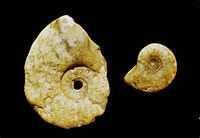
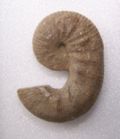
.; 2004: The Global Boundary Stratotype Section and Point (GSSP) for the base of the Cenomanian Stage, Mont Risou, Hautes-Alpes, France, Episodes 27, pp. 21–32.; 1842: Paléontologie française: Terrains crétacés, vol. ii.
Stratigraphic column
A stratigraphic column is a representation used in geology and its subfield of stratigraphy to describe the vertical location of rock units in a particular area....
. It is the youngest or uppermost subdivision of the Early/Lower Cretaceous
Early Cretaceous
The Early Cretaceous or the Lower Cretaceous , is the earlier or lower of the two major divisions of the Cretaceous...
epoch
Epoch (geology)
An epoch is a subdivision of the geologic timescale based on rock layering. In order, the higher subdivisions are periods, eras and eons. We are currently living in the Holocene epoch...
/series
Series (stratigraphy)
Series are subdivisions of rock layers made based on the age of the rock and corresponding to the dating system unit called an epoch, both being formally defined international conventions of the geological timescale. A series is therefore a sequence of rock depositions defining a...
. Its approximate time range is 112.0 ± 1.0 Ma to 99.6 ± 0.9 Ma (million years ago). The Albian is preceded by the Aptian
Aptian
The Aptian is an age in the geologic timescale or a stage in the stratigraphic column. It is a subdivision of the Early or Lower Cretaceous epoch or series and encompasses the time from 125.0 ± 1.0 Ma to 112.0 ± 1.0 Ma , approximately...
and followed by the Cenomanian
Cenomanian
The Cenomanian is, in the ICS' geological timescale the oldest or earliest age of the Late Cretaceous epoch or the lowest stage of the Upper Cretaceous series. An age is a unit of geochronology: it is a unit of time; the stage is a unit in the stratigraphic column deposited during the corresponding...
.
Stratigraphic definitions
The Albian stage (FrenchFrench language
French is a Romance language spoken as a first language in France, the Romandy region in Switzerland, Wallonia and Brussels in Belgium, Monaco, the regions of Quebec and Acadia in Canada, and by various communities elsewhere. Second-language speakers of French are distributed throughout many parts...
Albien, from Alba = the River Aube
Aube
Aube is a department in the northeastern part of France named after the Aube River. In 1995, its population was 293,100 inhabitants.- History :Aube is one of the original 83 departments created during the French Revolution on 4 March 1790...
in France
France
The French Republic , The French Republic , The French Republic , (commonly known as France , is a unitary semi-presidential republic in Western Europe with several overseas territories and islands located on other continents and in the Indian, Pacific, and Atlantic oceans. Metropolitan France...
) was first proposed in 1842 by Alcide d'Orbigny
Alcide d'Orbigny
Alcide Charles Victor Marie Dessalines d'Orbigny was a French naturalist who made major contributions in many areas, including zoology , palaeontology, geology, archaeology and anthropology....
.
The base of the Albian is defined as the place in the stratigraphic column where the coccolithophore
Coccolithophore
Coccolithophores are single-celled algae, protists, and phytoplankton belonging to the division of haptophytes. They are distinguished by special calcium carbonate plates of uncertain function called coccoliths , which are important microfossils...
species Praediscosphaera columnata first appears. A reference profile for the base of the Albian stage (its GSSP) had in 2009 not yet been established.
The top of the Albian stage (the base of the Cenomanian stage and Upper Cretaceous series) is defined as the place where the foram species Rotalipora globotruncanoides first appears in the stratigraphic column.
The Albian is sometimes subdivided in Early/Lower, Middle and Late/Upper subages or substages. In western Europe, especially in the UK, a subdivision in two substages (Vraconian and Gaultian) is more often used.
Lithofacies
The following representatives of the Albian stage are worthy of notice: the phosphoritePhosphorite
Phosphorite, phosphate rock or rock phosphate is a non-detrital sedimentary rock which contains high amounts of phosphate bearing minerals. The phosphate content of phosphorite is at least 15 to 20% which is a large enrichment over the typical sedimentary rock content of less than 0.2%...
beds of the Argonne
Argonne
Argonne may refer to:*The Forest of Argonne in France*Argonne National Laboratory, a U.S. D.O.E. National Laboratory near Chicago, Illinois*Meuse-Argonne Offensive, also called the Battle of Argonne Forest, a World War I battle*Argonne, Wisconsin, a town, US...
and Bray
Bray
Bray is a town in north County Wicklow, Ireland. It is a busy urban centre and seaside resort, with a population of 31,901 making it the fourth largest in Ireland as of the 2006 census...
areas in France; the Flammenmergel
Flammenmergel
The Flammenmergel is a lithological unit of the Lower Chalk in Germany.In Niedersachsen it reaches a depth of 110 to 150 m in the area of the Sackmulde...
of northern Germany
Germany
Germany , officially the Federal Republic of Germany , is a federal parliamentary republic in Europe. The country consists of 16 states while the capital and largest city is Berlin. Germany covers an area of 357,021 km2 and has a largely temperate seasonal climate...
; the lignite
Lignite
Lignite, often referred to as brown coal, or Rosebud coal by Northern Pacific Railroad,is a soft brown fuel with characteristics that put it somewhere between coal and peat...
s of Utrillas
Utrillas
Utrillas is a municipality located in the province of Teruel, Aragon, Spain. According to the 2004 census , the municipality has a population of 3,209 inhabitants....
in Spain
Spain
Spain , officially the Kingdom of Spain languages]] under the European Charter for Regional or Minority Languages. In each of these, Spain's official name is as follows:;;;;;;), is a country and member state of the European Union located in southwestern Europe on the Iberian Peninsula...
; the Upper sandstones of Nubia, and the Fredericksburg beds of North America
North America
North America is a continent wholly within the Northern Hemisphere and almost wholly within the Western Hemisphere. It is also considered a northern subcontinent of the Americas...
.
†Ankylosaurs
| Ankylosaurs of the Albian | ||||
|---|---|---|---|---|
| Taxa | Presence | Location | Description | Images |
|
   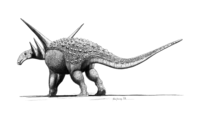 |
|||
|
||||
|
Anoplosaurus Anoplosaurus is an extinct genus of nodosaurid dinosaur, from the late Albian-age Lower Cretaceous Cambridge Greensand of Cambridgeshire, England... |
||||
|
Cedarpelta Cedarpelta is an extinct genus of basal ankylosaurid ankylosaur, based on material recovered from the Lower Cretaceous of North America. The skull lacks extensive cranial ornamentation, a trait which has been interpreted as plesiomorphic for ankylosaurs.... |
Cedar Mountain Formation Cedar Mountain Formation The Cedar Mountain Formation is the name given to distinctive sedimentary rocks in eastern Utah that occur between the underlying Morrison Formation and overlying Naturita Formation . It is composed of non-marine sediments, that is, sediments deposited in rivers, lakes and on flood plains... , Utah, USA |
|||
|
Gobisaurus Gobisaurus is an extinct genus of basal ankylosaurid ankylosaur from the Upper Cretaceous Ulansuhai Formation of China. The holotype consists of a skull and as yet undescribed postcranial remains. It was first named by Matthew K. Vickaryous, Anthony P. Russell, Philip J... |
Aptian Aptian The Aptian is an age in the geologic timescale or a stage in the stratigraphic column. It is a subdivision of the Early or Lower Cretaceous epoch or series and encompasses the time from 125.0 ± 1.0 Ma to 112.0 ± 1.0 Ma , approximately... to ?Albian |
Ulansuhai Formation Ulansuhai Formation The Ulansuhai Formation is a geological formation in Inner Mongolia, north China. Dinosaur remains are among the fossils that have been recovered from the formation.... , Inner Mongolia, China |
||
|
Pawpawsaurus Pawpawsaurus, meaning "Pawpaw Lizard", is a nodosaurid ankylosaur from the Cretaceous of Tarrant County, Texas, discovered in May 1992. The only species yet assigned to this taxon, Pawpawsaurus campbelli, is based on a complete skull from the marine Paw Paw Formation... |
||||
|
Sauropelta Sauropelta is a genus of nodosaurid dinosaur that existed in the Early Cretaceous Period of North America. One species has been named although others may have existed. Anatomically, Sauropelta is one of the most well-understood nodosaurids, with fossilized remains recovered in the U.S. states of... |
Aptian Aptian The Aptian is an age in the geologic timescale or a stage in the stratigraphic column. It is a subdivision of the Early or Lower Cretaceous epoch or series and encompasses the time from 125.0 ± 1.0 Ma to 112.0 ± 1.0 Ma , approximately... to Albian |
Cloverly Formation Cloverly Formation The Cloverly Formation are Lower Cretaceous strata located in Montana and Wyoming, in the western United States. The term now includes strata that had formerly been called the Dakota Formation in central and southern Wyoming.-Members:... , Wyoming, Montana, Utah, USA |
A medium-sized nodosaurid, measuring about 5 meters (16.5 ft) long, Sauropelta had a distinctively long tail which made up about half of its body length. Its neck and back were protected by an extensive bony body armor including characteristically large spines | |
|
Shamosaurus Shamosaurus is an extinct genus of basal ankylosaurid ankylosaur from Early Cretaceous deposits of Höövör, Mongolia. Shamosaurus is known from the holotype PIN N 3779/2 complete skull and jaw and the paratypes include partial skeleton remains and an armor. It was collected from the... |
Mongolia | |||
|
Silvisaurus Silvisaurus, from the Latin silva "woodland" and Greek saurus "lizard", is a nodosaurid ankylosaur from the middle Cretaceous of Kansas.-Discovery and species:... |
Dakota Formation Dakota Formation The Dakota Formation is a geologic formation composed of sedimentary rocks deposited on the western side of the Late Cretaceous Western Interior Seaway. F.B. Meek and F.V. Hayden named it for exposures along the Missouri River near Dakota City, Nebraska... , Kansas, USA |
A nodosaurid estimated to have been approximately four meters in length (13 ft). Besides the usual rounded and polygonal osteoderms, Silvisaurus may have also sported bony spines on its shoulders and tail | ||
|
Stegopelta Stegopelta is a genus of armored dinosaur. It is based on a partial skeleton from the latest Albian-earliest Cenomanian-age Lower and Upper Cretaceous Belle Fourche Member of the Frontier Formation of Fremont County, Wyoming.... |
Late Albian to early Cenomanian Cenomanian The Cenomanian is, in the ICS' geological timescale the oldest or earliest age of the Late Cretaceous epoch or the lowest stage of the Upper Cretaceous series. An age is a unit of geochronology: it is a unit of time; the stage is a unit in the stratigraphic column deposited during the corresponding... |
Frontier Formation Frontier Formation The Frontier Formation is a sedimentary geological formation whose strata date back to the Late Cretaceous. The formation's extents are: northwest Colorado, southeast Idaho, southern Montana, northern Utah, and western Wyoming. It occurs in many sedimentary basins and uplift areas.The formation... , Wyoming, USA |
A poorly known genus of nodosaurid | |
|
Texasetes Texasetes is a genus of ankylosaurian dinosaur from the late Lower Cretaceous of North America. This poorly known genus has been recovered from the Paw Paw Formation near Haslet, Tarrant County Texas, which has also produced the nodosaurid ankylosaur Pawpawsaurus... |
Paw Paw Formation Paw Paw Formation The Paw Paw Formation is a geological formation in Texas whose strata date back to the Early Cretaceous. Dinosaur remains are among the fossils that have been recovered from the formation.-Vertebrate paleofauna:* Pawpawsaurus campbelli - "Skull."... , Texas, USA |
Poorly known, probably a nodosaurid | ||
Birds
| Birds of the Albian | ||||
|---|---|---|---|---|
| Taxa | Presence | Location | Description | Images |
|
 |
|||
|
|
||||
Bony Fish
| Bony Fish of the Albian | ||||
|---|---|---|---|---|
| Taxa | Presence | Location | Description | Images |
|
 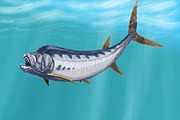 |
|||
|
||||
Cartilaginous Fish
| Cartilaginous fish of the Albian | ||||
|---|---|---|---|---|
| Taxa | Presence | Location | Description | Images |
|
  |
|||
|
||||
|
Scapanorhynchus Scapanorhynchus is an extinct genus of shark from the Cretaceous era. Their extreme similarities to the living goblin shark, Mitsukurina owstoni, lead some experts to consider reclassifying it as Scapanorhynchus owstoni... |
||||
†Ceratopsia
| Ceratopsia Ceratopsia Ceratopsia or Ceratopia is a group of herbivorous, beaked dinosaurs which thrived in what are now North America, Europe, and Asia, during the Cretaceous Period, although ancestral forms lived earlier, in the Jurassic. The earliest known ceratopsian, Yinlong downsi, lived between 161.2 and 155.7... of the Albian |
||||
|---|---|---|---|---|
| Taxa | Presence | Location | Description | Images |
|
Gobi Desert Gobi Desert The Gobi is a large desert region in Asia. It covers parts of northern and northwestern China, and of southern Mongolia. The desert basins of the Gobi are bounded by the Altai Mountains and the grasslands and steppes of Mongolia on the north, by the Hexi Corridor and Tibetan Plateau to the... , Mongolia |
Had an intermediate phylogenetic position between Liaoceratops Liaoceratops Liaoceratops, meaning "Liao Horned Face", is a ceratopsian dinosaur believed to be an early relative of the horned ceratopsids. It lived in the early Cretaceous, some 130 million years ago. It was discovered in China by a team of American and Chinese scientists... and Archaeoceratops Archaeoceratops Archaeoceratops, meaning "ancient horned face", is a genus of basal neoceratopsian dinosaur from the Early Cretaceous of north central China. It appears to have been bipedal and quite small with a comparatively large head... within Neoceratopia |
 |
|
Crocodylomorphs
| Crocodylomorphs of the Albian | ||||
|---|---|---|---|---|
| Taxa | Presence | Location | Description | Images |
|
Africa |  |
||
†Ichthyosaurs
| Ichthyosaurs of the Albian | ||||
|---|---|---|---|---|
| Taxa | Presence | Location | Description | Images |
|
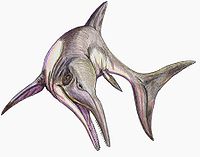 |
|||
Mammalia
| Mammals of the Albian | ||||
|---|---|---|---|---|
| Taxa | Presence | Location | Description | Images |
|
several species from Hauterivian to Albian | Spain, Mongolia | 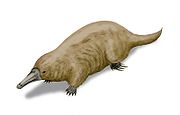 |
|
|
Kollikodon Kollikodon ritchiei is a fossil monotreme species. It is known only from an opalised dentary fragment, with one premolar and two molars in situ... |
Lightning Ridge, New South Wales, Australia | |||
|
Steropodon Steropodon galmani was a prehistoric species of monotreme, or egg-laying mammal, that lived during the middle Albian stage, in the Lower Cretaceous period... |
Lightning Ridge, New South Wales, Australia | |||
†Ornithopods
| Ornithopods of the Albian | ||||
|---|---|---|---|---|
| Taxa | Presence | Location | Description | Images |
|
Khukhtek Formation, Dornogovi Province, Mongolia | An advanced iguanodontian, just basal to the family Hadrosauridae |
 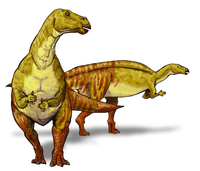  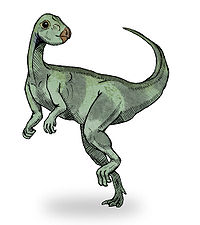   |
|
|
Aptian Aptian The Aptian is an age in the geologic timescale or a stage in the stratigraphic column. It is a subdivision of the Early or Lower Cretaceous epoch or series and encompasses the time from 125.0 ± 1.0 Ma to 112.0 ± 1.0 Ma , approximately... /Albian |
Dinosaur Cove Dinosaur Cove Not to be confused with the children's book series of the same name.Dinosaur Cove in Victoria, Australia is a fossil bearing site in south-east of the continent where the Otway Ranges meet the sea to the west of Cape Otway, adjacent to Great Otway National Park .The inaccessible ocean-front cliffs... , Victoria, Australia |
2-3 meters long hypsilophodont | |
|
Eolambia Eolambia is a genus of herbivorous iguanodontian dinosaur from the mid-Cretaceous Period of the USA.In 1992 Carole Jones and her husband Ramal Jones near Castle Dale in Emery County, Utah, on the San Rafael Swell Anticline discovered a fossil site which would be named the Carol Quarry in her honour... |
Albian-Cenomanian Cenomanian The Cenomanian is, in the ICS' geological timescale the oldest or earliest age of the Late Cretaceous epoch or the lowest stage of the Upper Cretaceous series. An age is a unit of geochronology: it is a unit of time; the stage is a unit in the stratigraphic column deposited during the corresponding... |
Utah, USA | An iguanodont | |
|
Leaellynasaura Leaellynasaura is a genus of small herbivorous ornithischian dinosaur from the Albian stage of the Early Cretaceous, first discovered in Dinosaur Cove, Australia. The type species is Leaellynasaura amicagraphica... |
||||
|
Muttaburrasaurus Muttaburrasaurus is a genus of herbivorous ornithopod dinosaur, living in what is now northeastern Australia between 100 and 98 million years ago during the early Cretaceous Period. It has been recovered in some analyses as a member of the iguanodontian family Rhabdodontidae... |
||||
|
Nanyangosaurus Nanyangosaurus is a genus of herbivorous ornithischian dinosaur from the Early Cretaceous. It was an iguanodont which lived in the area of present-day China.... |
China | |||
|
Penelopognathus Penelopognathus is a genus of dinosaur which lived during the Early Cretaceous. It was an iguanodont ancestral to hadrosaurids. Fossils have been found in the Bayin-Gobi Formation in what is now Mongolia... |
Mongolia | |||
|
Probactrosaurus Probactrosaurus is an early herbivorous hadrosauroid iguanodont dinosaur. It lived in China during the Early Cretaceous period.... |
China | An early hadrosauroid iguanodont, about 17 - 20 feet (5 - 6 metres) in length. It had a narrow snout, an elongated lower jaw and double rows of flattened cheek teeth. It was a possible ancestor of the duck-billed dinosaurs. | ||
|
Qantassaurus Qantassaurus is a genus of two-legged, plant-eating ornithischian dinosaur that lived in Australia about 115 million years ago, when the continent was still partly south of the Antarctic Circle... |
||||
|
Siluosaurus Siluosaurus is a genus of ornithopod dinosaur from the Barremian-Albian-age Lower Cretaceous Xinminbao Group of Gansu, China. It is based on IVPP V.11117 , two teeth... |
Barremian Barremian The Barremian is an age in the geologic timescale between 130.0 ± 1.5 Ma and 125.0 ± 1.0 Ma). It is a subdivision of the Early Cretaceous epoch... to Albian |
|||
|
Tenontosaurus Tenontosaurus is a genus of medium- to large-sized ornithopod dinosaur. The genus is known from the late Aptian to Albian ages of the middle Cretaceous period sediments of western North America, dating between 115 to 108 million years ago... |
||||
|
Theiophytalia Theiophytalia is a genus of herbivorous iguanodontian dinosaur from the lower Cretaceous period of Colorado.-Etymology:... |
Aptian Aptian The Aptian is an age in the geologic timescale or a stage in the stratigraphic column. It is a subdivision of the Early or Lower Cretaceous epoch or series and encompasses the time from 125.0 ± 1.0 Ma to 112.0 ± 1.0 Ma , approximately... to Albian |
Purgatoire Formation, Colorado, USA | An iguanodont described as intermediate in derivation between Camptosaurus Camptosaurus Camptosaurus is a genus of plant-eating, beaked ornithischian dinosaurs of the Late Jurassic period of western North America. The name means 'flexible lizard', .... and Iguanodon Iguanodon Iguanodon is a genus of ornithopod dinosaur that lived roughly halfway between the first of the swift bipedal hypsilophodontids and the ornithopods' culmination in the duck-billed dinosaurs... |
|
|
Zephyrosaurus Zephyrosaurus is a genus of hypsilophodont ornithopod dinosaur. It is based on a partial skull and postcranial fragments discovered in the Aptian-Albian-age Lower Cretaceous Cloverly Formation of Carbon County, Montana... |
Aptian Aptian The Aptian is an age in the geologic timescale or a stage in the stratigraphic column. It is a subdivision of the Early or Lower Cretaceous epoch or series and encompasses the time from 125.0 ± 1.0 Ma to 112.0 ± 1.0 Ma , approximately... to Albian |
Cloverly Formation Cloverly Formation The Cloverly Formation are Lower Cretaceous strata located in Montana and Wyoming, in the western United States. The term now includes strata that had formerly been called the Dakota Formation in central and southern Wyoming.-Members:... , Montana, USA |
Hypsilophodont | |
†Plesiosaurs
| †Plesiosauria Plesiosauria Plesiosauria is an order of Mesozoic marine reptiles. Plesiosaurs first appeared in the Early Jurassic Period and became especially common during the Jurassic Period, thriving until the K-T extinction at the end of the Cretaceous Period.The name "plesiosaur" is used to refer to the order... of the Albian |
||||
|---|---|---|---|---|
| Taxa | Presence | Location | Description | Images |
|
Aptian Aptian The Aptian is an age in the geologic timescale or a stage in the stratigraphic column. It is a subdivision of the Early or Lower Cretaceous epoch or series and encompasses the time from 125.0 ± 1.0 Ma to 112.0 ± 1.0 Ma , approximately... to Albian |
Hughenden district, Queensland, Australia | Among the largest pliosaurs, body-length estimates put the total length of Kronosaurus at 9–10 meters |
 |
†Pterosauria
| Pterosaurs of the Albian | ||||
|---|---|---|---|---|
| Taxa | Presence | Location | Description | Images |
|
Cambridge Greensand Cambridge Greensand The Cambridge Greensand is a geological formation in England whose strata date back to the Early Cretaceous. Dinosaur remains are among the fossils that have been recovered from the formation.-Vertebrate paleofauna:... , United Kingdom |
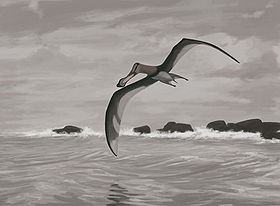 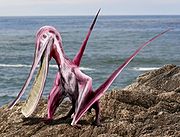 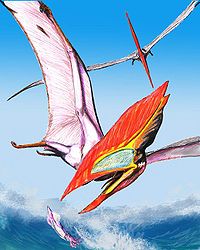 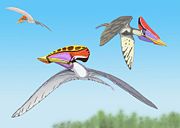 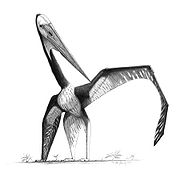 |
||
|
Morocco; Santana Formation Santana Formation The Santana Formation is a geologic Lagerstätte in northeastern Brazil's Araripe Basin where the states of Pernambuco, Piauí and Ceará come together. The geological formation, named after the village of Santana do Cariri, lies at the base of the Araripe Plateau... , Brazil; Paw Paw Formation Paw Paw Formation The Paw Paw Formation is a geological formation in Texas whose strata date back to the Early Cretaceous. Dinosaur remains are among the fossils that have been recovered from the formation.-Vertebrate paleofauna:* Pawpawsaurus campbelli - "Skull."... , Texas, USA |
|||
|
Lonchognathosaurus Lonchognathosaurus was a genus of dsungaripterid pterodactyloid pterosaur from the Albian-age Lower Cretaceous Lianmuqin Formation of Xinjiang, China.... |
Lianmuxin Formation, Xinjiang, China | |||
|
Pterodaustro Pterodaustro is a genus of Cretaceous pterodactyloid pterosaur from South America, which lived 105 million years ago.-Naming:The genus was named in 1969 by José Bonaparte as an as yet undescribed nomen nudum. The first description followed in 1970, making the name valid, the type species being... |
Valanginian Valanginian In the geologic timescale, the Valanginian is an age or stage of the Early or Lower Cretaceous. It spans between 140.2 ± 3.0 Ma and 136.4 ± 2.0 Ma... to Albian |
Lagarcito Formation, Argentina | ||
|
Santanadactylus Santanadactylus was a genus of pterodactyloid pterosaur from the Aptian-age Romualdo Member of the Lower Cretaceous Santana Formation, of Barra do Jardim, Araripe Plateau, Ceará Province, Brazil. Four species have been named, but today it is doubted they are part of the same genus... |
Aptian Aptian The Aptian is an age in the geologic timescale or a stage in the stratigraphic column. It is a subdivision of the Early or Lower Cretaceous epoch or series and encompasses the time from 125.0 ± 1.0 Ma to 112.0 ± 1.0 Ma , approximately... or Albian |
Santana Formation Santana Formation The Santana Formation is a geologic Lagerstätte in northeastern Brazil's Araripe Basin where the states of Pernambuco, Piauí and Ceará come together. The geological formation, named after the village of Santana do Cariri, lies at the base of the Araripe Plateau... , Brazil |
||
|
Thalassodromeus Thalassodromeus was a large pterodactyloid pterosaur found in northeastern Brazil.The genus was named in 2002 by Alexander Kellner and Diogenes de Almeida Campos. The type species is Thalassodromeus sethi. The genus name is derived from Greek thalasse, "sea" and dromaios, "runner", in reference to... |
Aptian Aptian The Aptian is an age in the geologic timescale or a stage in the stratigraphic column. It is a subdivision of the Early or Lower Cretaceous epoch or series and encompasses the time from 125.0 ± 1.0 Ma to 112.0 ± 1.0 Ma , approximately... to early Albian |
Santan do Cariri, Brazil; St Gallen, Switzerland | ||
|
Tupuxuara Tupuxuara is a genus of large, crested, toothless pterodactyloid pterosaur.The genus was in 1988 named and described by Alexander Kellner and Diogenes de Almeida Campos. The type species is Tupuxuara longicristatus. The genus name refers to a familiar spirit from the mythology of the Tupi... |
Albian or Cenomanian Cenomanian The Cenomanian is, in the ICS' geological timescale the oldest or earliest age of the Late Cretaceous epoch or the lowest stage of the Upper Cretaceous series. An age is a unit of geochronology: it is a unit of time; the stage is a unit in the stratigraphic column deposited during the corresponding... |
Santana Formation Santana Formation The Santana Formation is a geologic Lagerstätte in northeastern Brazil's Araripe Basin where the states of Pernambuco, Piauí and Ceará come together. The geological formation, named after the village of Santana do Cariri, lies at the base of the Araripe Plateau... , Brazil |
||
|
Zhejiangopterus Zhejiangopterus is a genus of azhdarchid pterosaur known from one species, which lived in China during the late Cretaceous Period.The genus was named in 1994 by Chinese paleontologists Cai Zhengquan and Wei Feng. The type species is Zhejiangopterus linhaiensis. The genus name refers to Zhejiang... |
? | Zhejiang, China | ||
†Sauropods
| Sauropods Sauropoda Sauropoda , or the sauropods , are an infraorder of saurischian dinosaurs. They had long necks, long tails, small heads , and thick, pillar-like legs. They are notable for the enormous sizes attained by some species, and the group includes the largest animals to have ever lived on land... of the Albian |
||||
|---|---|---|---|---|
| Taxa | Presence | Location | Description | Images |
|
Africa |
 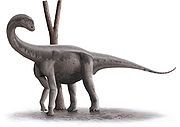 |
||
|
||||
|
Argentinosaurus Argentinosaurus is a genus of titanosaur sauropod dinosaur first discovered by Guillermo Heredia in Argentina. The generic name refers to the country in which it was discovered... |
||||
|
Brontomerus Brontomerus is a genus of camarasauromorph sauropod which lived during the early Cretaceous . It was named in 2011 and the type species is Brontomerus mcintoshi... |
||||
|
Chubutisaurus Chubutisaurus is a genus of dinosaur from the Early Cretaceous Period. It lived in South America. It is classified as a sauropod, specifically one of the titanosaurs. The type species, C. insignis, was described by del Corro in 1975. Its fossils were found in the Cerro Barcino Formation, Albian... |
||||
|
Jobaria Jobaria was a sauropod dinosaur discovered in the Sahara Desert in 1997. It was named after "Jobar", a creature of local legends, and is thought to have been about 18 metres long. It was found in the Tiourarén Formation, originally thought to represent the Hauterivian to Barremian stages of the... |
Aptian Aptian The Aptian is an age in the geologic timescale or a stage in the stratigraphic column. It is a subdivision of the Early or Lower Cretaceous epoch or series and encompasses the time from 125.0 ± 1.0 Ma to 112.0 ± 1.0 Ma , approximately... or Albian |
|||
|
Sauroposeidon Sauroposeidon is a genus of sauropod dinosaur known from four neck vertebrae that were found in the southeastern portion of the US state of Oklahoma. The fossils were found in rocks dating to the Early Cretaceous, a period when the sauropods of North America had diminished in both size and... |
||||
†Theropods (non-avian)
| Theropods Theropoda Theropoda is both a suborder of bipedal saurischian dinosaurs, and a clade consisting of that suborder and its descendants . Dinosaurs belonging to the suborder theropoda were primarily carnivorous, although a number of theropod groups evolved herbivory, omnivory, and insectivory... of the Albian |
||||
|---|---|---|---|---|
| Taxa | Presence | Location | Description | Images |
|
North America |
    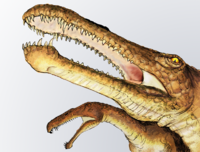 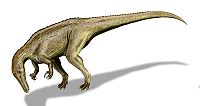  |
||
|
Asia | |||
|
Cristatusaurus Cristatusaurus is an extinct genus of spinosaurid theropod dinosaur. It lived during the Early Cretaceous Period of what is now Africa.... |
Niger | |||
|
Deinonychus Deinonychus was a genus of carnivorous dromaeosaurid dinosaur. There is one described species, Deinonychus antirrhopus. This 3.4 meter long dinosaur lived during the early Cretaceous Period, about 115–108 million years ago . Fossils have been recovered from the U.S... |
North America | |||
|
Erectopus Erectopus is an allosauroid theropod from the Lower Cretaceous of France.The material comprising the type series was discovered in the late 19th century from the Phosphate-bearing beds of La Penthèive at Louppy-le-Château in eastern France, which have also produced remains of plesiosaurs,... |
||||
|
Genusaurus Genusaurus is a genus of dinosaur from the Early Cretaceous. Its fossils were found in France. Scientists have estimated the length of Genusaurus to have been 3 m and its weight 50 kg... |
France | |||
|
Irritator Irritator is a genus of spinosaurid dinosaur that lived in the early Cretaceous Period , around 110 million years ago. Current estimations indicate a length of 8 meters . It was found in Brazil... |
South America | |||
|
Fukuiraptor Fukuiraptor was a medium-sized carnivore of the Early Cretaceous that lived in what is now Japan. Scientists first thought it was a member of the Dromaeosauridae, but after studying the fossils they now believe it was related to Allosaurus in the family Neovenatoridae. The type specimen is the... |
Japan | |||
|
Spinosaurus Spinosaurus is a genus of theropod dinosaur which lived in what is now North Africa, from the lower Albian to lower Cenomanian stages of the Cretaceous period, about 112 to 97 million years ago. This genus was first known from Egyptian remains discovered in 1912 and described by German... |
Africa | |||
|
Suchomimus Suchomimus is a genus of large spinosaurid dinosaur with a crocodile-like mouth that lived sometime between 121-112 million years ago, during the late Aptian stage of the Cretaceous period in Africa.-Description:... |
Africa | |||
|
Timimus Timimus is a genus of small coelurosaurian theropod dinosaur, which was originally identified as an ornithomimosaur, from the Early Cretaceous of Australia.-Discovery and species:... |
Australia | |||
|
Utahraptor Utahraptor is a genus of theropod dinosaurs, including the largest known members of the family Dromaeosauridae. Fossil specimens date to the upper Barremian stage of the early Cretaceous period... |
North America | The largest known dromaeosaurid | ||
Originating in Lower Albian Strata
The following is a list of Ammonite genera whose fossils are geochronologically found first in lower Albian strata. These genera may survive into later portions of the Albian stage, or even into later geological stages. This list should not be thought of in terms of the lifespan of the genera included.
- AiolocerasAiolocerasAioloceras is an ammonite, order Ammonitida, from near the end of the Early Cretaceous. The shell is compressed with the outer whorl covering much of the previous. Sides are slightly convex, converge toward a narrowly ached venter. Inner whorls have sharp falcoid ribs, outer are smooth. Umbilical...
- AnacleonicerasAnacleonicerasAnacleoniceras is an extinct genus of cephalopod belonging to the Ammonite subclass....
- AnadesmocerasAnadesmocerasAnadesmoceras is an hoplitid ammonite from the lower Albian of England, included in the subfamily Cleoniceratinae. Anadesmoceras has a shell shaped more or less like a compressed Cleoniceras but with faint ornament only on the inner whorls. The shell has bundled growth striae...
- AnisocerasAnisocerasAnisoceras is an extinct genus of cephalopods belonging to the Anisoceratidae family of the Ammonite subclass.- References :* http://paleodb.org/cgi-bin/bridge.pl?action=checkTaxonInfo&taxon_no=14564&is_real_user=1...
- ArcthoplitesArcthoplitesArcthoplites is an extinct genus of cephalopod belonging to the Ammonite subclass....
- Brancoceras
- Brewericeras
- CleonicerasCleonicerasCleoniceras is a rather involute, high-whorled hoplitid from the Lower to basal Middle Albian of Europe, Madagascar, and Transcaspian region...
- Cymahoplites
- DouvilleicerasDouvilleicerasDouvilleiceras is a genus of ammonite from the Cretaceous. Its fossils have been found in Europe, North America, and South America.-External links:* in the Paleobiology Database...
- Epileymeriella
- Eubranoceras
- Farnhamia
- Hoplites
- Kossmatella
- Labeceras
- Leconteites
- Lemuroceras
- Leymeriella
- Lyelliceras
- Neobibolites
- Otohoplites
- Oxytropidoceras
- Paracanthoplites
- Parasilesites
- Parengonoceras
- Plictetia
- Prohelicoceras
- Proleymeriella
- Prolyelliceras
- Protohoplites
- Pseudoleymeriella
- Pseudosonneratia
- Puzosia
- Puzosigella
- Rhytidohoplites
- Rossalites
- Silesitoides
- Sokolovites
- SonneratiaSonneratiaSonneratia is a genus of plants in the family Lythraceae. Formerly the Sonneratia were placed in a family called Sonneratiaceae which included both the Sonneratia and the Duabanga, but these two are now placed in their own monotypic subfamilies of the family Lythraceae...
- Tegoceras
- Tetrahoplites
- Tetrahoplitoides
- ZealanditesZealanditesZealandites is an extinct genus of cephalopod belonging to the Ammonite subclass....
Originating in Middle Albian Strata
The following is a list of Ammonite genera whose fossils are geochronologically found first in middle Albian strata. These genera may survive into later portions of the Albian stage, or even into later geological stages. This list should not be thought of in terms of the lifespan of the genera included.
- AnagaudrycerasAnagaudrycerasAnagaudryceras is an extinct genus of cephalopod belonging to the Ammonite family Gaudryceratidae.-References:* Accessed on 9/24/07...
- AnahoplitesAnahoplitesAnahoplites is an extinct genus of cephalopod belonging to the Ammonite subclass....
- AstiericerasAstiericerasAstiericeras is an extinct genus of cephalopod belonging to the Ammonite subclass....
- Dimorphoplites
- Dipoloceras
- Dipoloceroides
- Engonoceras
- Epihoplites
- EuhoplitesEuhoplitesEuhoplites is an extinct ammonoid cephalopod from the Lower Creataceous, characterized bystrongly ribbed, more or less evolute, compressed to inflated shells with flat or concave rims, typically with a deep narrow groove running down the middle. In some, ribs seem to zigzag between umbilical...
- Falciferella
- Falloticeras
- Gastroplites
- Hamitoides
- Hysteroceras
- Isohoplites
- Manuaniceras
- Mojsisoviczia
- MortonicerasMortonicerasMortoniceras is an ammonoid genus belonging to the superfamily Acanthocerataceae, named by Meek in 1876, based on Ammonites vespertinu, named by Morton in 1834....
- Ostlingoceras
- Protengonoceras
- Proturrilitoides
- Pseudhelicoceras
- Scaphamites
- Subarcthoplites
- Sulcohoplites
- Turrilitoides
- Venezoliceras
- ZuluscaphitesZuluscaphitesZuluscaphites is an extinct genus of cephalopod belonging to the Ammonite subclass....
Originating in Upper Albian Strata
The following is a list of Ammonite genera whose fossils are geochronologically found first in upper Albian strata. These genera may survive into later portions of the Albian stage, or even into later geological stages. This list should not be thought of in terms of the lifespan of the genera included.


- AdkinsitesAdkinsitesAdkinsites is an extinct genus of cephalopod belonging to the Ammonite subclass....
- ArestocerasArestocerasArestoceras is an extinct genus of cephalopod belonging to the Ammonite subclass....
- BeudantiellaBeudantiellaBeudantiella is an extinct genus of cephalopod belonging to the Ammonite subclass....
- BhimaitesBhimaitesBhimaites is an extinct genus of cephalopod belonging to the Ammonite subclass....
- Borissiakoceras
- Cainoceras
- Callihoplites
- Cantabrigites
- Cenisella
- Cottreauites
- Cyrtochilus
- Deiradoceras
- Diplasioceras
- Discohoplites
- Ellipsoceras
- Elobiceras
- Eogunnarites
- Eopachydiscus
- Eoscaphites
- Erioliceras
- Ficheuria
- Flickia
- Gaudryceras
- Gazdaganites
- Goodhallites
- Hemiptychoceras
- Hengestites
- Hypengonoceras
- Hyphoplites
- Idiohamites
- KaramaicerasKaramaicerasKaramaiceras is an extinct cephalopod genus belonging to the Ammonoidea that lived during the Early Cretaceous. Its shell is involute, smooth and rather compressed, with the outer whorl strongly embracing the inner whorls. Sides are flattish to slightly convex and slope inwardly toward a narrowly...
- KaramaitesKaramaitesKaramites is an extinct cephalopoda genus belonging to the Ammonoidea and included in the hoplitacean family Placenticeratidae.Karamites lived during the latest Albian , derived from Semenoviceras. It is the typical form for Central Asia where it occurs with members of the Hoplitidae, e.g....
- Koloceras
- LechitesLechitesLechites – an ethnic and linguistic group of West Slavs, the ancestors of modern Poles and the historical Pomeranians and Polabians.-History:...
- Lepthoplites
- Lytodiscoides
- Mantelliceras
- MariellaMariellaMariella is an ammonoid genus, named by Nowak from the upper Albian and Cenomanian stages of the mid Cretaceous, included in the Turrilitidae. Its type is Turrilites bergeri-References:*...
- Metengonoceras
- Myloceras
- Neogastroplites
- Neoharpoceras
- Neokentoceras
- Neophlycticeras
- Pachydesmoceras
- Paradolphia
- Paraturrilites
- Pervinquieria
- Plesiohamites
- Plesioturrilites
- Pleurohoplites
- Prohysteroceras
- Psilohamites
- Rusoceras
- Salaziceras
- Saltericeras
- ScaphitesScaphitesScaphites is a genus of extinct cephalopod belonging to the family of heteromorph ammonites . They were a widespread genus that thrived during the Cretaceous period....
- SchloenbachiaSchloenbachiaSchloenbachia is an ammonoid cephalopod genus from the Cenomanian stage of the Upper Cretaceous, and type for the Schloenbachiidae, a family within the ammonitid Hoplitaceae....
- Sciponoceras
- Semenovites
- Spathiceras
- Stoliczkaia
- Stomohamites
- Worthoceras
Belemnites
| Belemnites of the Albian | ||||
|---|---|---|---|---|
| Taxa | Presence | Location | Description | Images |
|
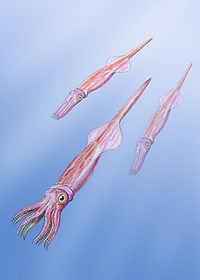 |
|||
|
Dimitobelus Dimitobelus is a genus of belemnite, an extinct group of cephalopods.... |
||||
Nautiloids
| Nautiloids of the Albian | ||||
|---|---|---|---|---|
| Taxa | Presence | Location | Description | Images |
|
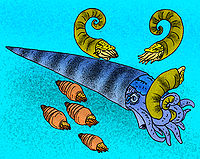 |
|||
Literature
; 2004: A Geologic Time Scale 2004, Cambridge University PressCambridge University Press
Cambridge University Press is the publishing business of the University of Cambridge. Granted letters patent by Henry VIII in 1534, it is the world's oldest publishing house, and the second largest university press in the world...
.; 2004: The Global Boundary Stratotype Section and Point (GSSP) for the base of the Cenomanian Stage, Mont Risou, Hautes-Alpes, France, Episodes 27, pp. 21–32.; 1842: Paléontologie française: Terrains crétacés, vol. ii.
External links
- GeoWhen Database - Albian
- Mid-Cretaceous timescale, at the website of the subcommission for stratigraphic information of the ICS (The top of the Albian stage is also still visible on their Late Cretaceous timescale)
- Stratigraphic chart of the Lower Cretaceous, at the website of Norges Network of offshore records of geology and stratigraphy
- Albian Stage, Cretaceous Period in Hampshire

